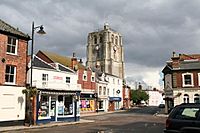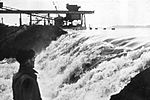Hester Burton facts for kids
Quick facts for kids
Hester Burton
|
|
|---|---|

Burton's hometown of Beccles, Suffolk
|
|
| Born | Hester Wood-Hill 6 December 1913 Beccles, Suffolk, England |
| Died | 17 September 2000 (aged 86) Oxford, Oxfordshire, England |
| Occupation | Writer |
| Language | English |
| Nationality | British |
| Genre | Children's historical fiction |
| Notable works |
|
| Notable awards | Carnegie Medal 1963 |
Hester Burton (6 December 1913 – 17 September 2000) was an English writer, mainly of historical fiction for children and young adults. She received the Carnegie Medal for her 1963 novel Time of Trial, which like many of her books was illustrated by Victor Ambrus.
Contents
Early life

She was born Hester Wood-Hill on 6 December 1913, in Beccles, Suffolk, where her father was elected town Mayor three times. From 1925 to 1936, she attended Headington School, Oxford and then St Anne's College, Oxford, where she received an honours degree in English. In 1937, she married Reginald W. B. Burton, a Classics don at Oriel College. They had three daughters.
Non-fiction
In 1949, Burton published a biography of Barbara Bodichon, the 19th-century feminist, artist and educationalist. She worked for Oxford University Press from 1956 to 1964, contributing two volumes to the Oxford Sheldonian English Series for secondary schoolchildren: Coleridge and the Wordsworths, 1953, and Tennyson in 1954. She worked as an assistant editor for the revised Oxford Junior Encyclopaedia, and edited two 1959 anthologies: A Book of Modern Stories and Her First Ball.
In addition, Burton edited works by friends and colleagues, including Thomas Hardy: Distracted Preacher? Hardy's Religious Biography and its Influence on his Novels by Timothy R. Hands and Mike Esbester.
Fiction
Her first children's novel was The Great Gale, published in 1960 and inspired by the devastation inflicted by the North Sea flood of 1953 on her home county of Suffolk. Her subject matter often reflected a radical approach first popularised by Geoffrey Trease. It included the slave trade in To Ravensrigg and the Captain Swing riots of the 1830s in No Beat of Drum and Otmoor for Ever. She sometimes covered similar themes for different age groups; Beyond the Weir Bridge was written for teens, while the same issues and events appear in Through the Fire, aimed at six-to-nine year olds. Several of her books are set in Suffolk, with many also having a maritime or naval setting.
Rather than seeking to balance diverging views, Burton presented her stories from the perspectives of an individual or group of individuals, which she viewed as more authentic. In a 1973 interview, she explained this as follows: "I am not all-wise or all-knowing... but neither were the people actually taking part.... It is a wise precaution for a writer of historical fiction to limit this range of vision... [and] also much better art."
Many of her books, including No Beat of Drum and A Time of Trial, reflect the impact of inequalities in society on her protagonists, their willingness to challenge these and the importance of education in that process. As shown by her biography of Victorian feminist Barbara Bodichon, Burton had an abiding interest in women's issues; her novels portrayed strong and independent heroines, with many of Ambrus' cover illustrations emphasising the female character.
The Oxford Encyclopedia of Children's Literature summarises her novels as "featuring heroines with strong opinions; class tensions and social justice are recurring themes. Her writing is unsentimental... and her books accounts of ordinary young people affected by national events."
In a letter written in February, 2006, one of Burton's daughters wrote; "I could always tell when Mum had another book on her mind, she would start to cook the meal while still wearing her overcoat and hat.
Death
Hester Burton died on 17 September 2000 in Oxford, after a stroke suffered at the age of 86.
Fiction for older readers
- The Great Gale (1960), also titled The Flood at Reedsmere; the North Sea flood of 1953;
- Castors Away! (1962) on the Napoleonic wars
- Time of Trial (1963) on free speech in the early 19th century
- A Seaman at the Time of Trafalgar (1963) on the Napoleonic wars at sea
- No Beat of Drum (1966) on social unrest in 1830 and transportation to Van Diemen's Land, modern Tasmania;
- In Spite of All Terror (1968) on the beginning of the Second World War, Dunkirk and evacuation
- Thomas (1969, in the US as Beyond the Weir Bridge) on the English Civil War and after
- The Henchmans at Home (1970), also titled The Day That Went Terribly Wrong: And Other Stories; family life in Victorian Suffolk;
- The Rebel (1971) on Revolutionary France
- Riders of the Storm (1972) on education and unrest in 18th-century England
- Kate Rider (1974) on the English Civil War: the Siege of Colchester
- To Ravensrigg (1976) on the Liverpool slave trade;
- A Grenville Goes to Sea (1977) on Nelson's navy
- When the Beacons Blazed (1978) on the Spanish Armada
- Five August Days (1981), a contemporary adventure;
Fiction for younger readers
These were published as part of the Antelope Series, intended for readers of six-nine years.
- Otmoor for Ever (1968); Jake and his brother Seth resist as the common land of Otmoor is enclosed by the local land-owners using fences and hedges.
- Through the Fire (1969); covers many of the themes of Thomas including the persecution of the Quakers under the Restoration. Rachel and Will ride into London with their father to take food to their imprisoned friends but are trapped when the Great Fire of London breaks out.
- Tim at the Fur Fort (1977); in early 19th century Canada, Tim works as an accountant for the Hudson's Bay Company in what is now British Columbia but wants to be an explorer. When disease strikes Fort Frederick, he has to prove himself by making the most dangerous journey of his life.
Non-fiction
- Barbara Bodichon (1949), a short biography of the 19th century feminist, artist and educationalist Barbara Bodichon
- Coleridge and the Wordsworths (1953); Oxford Sheldonian English Series;
- Tennyson (1954); Oxford Sheldonian English Series;
- (including 1 "from old catalog")

